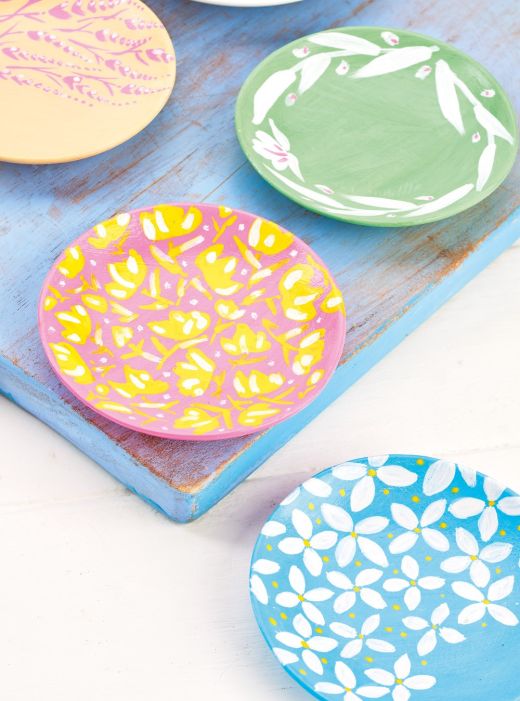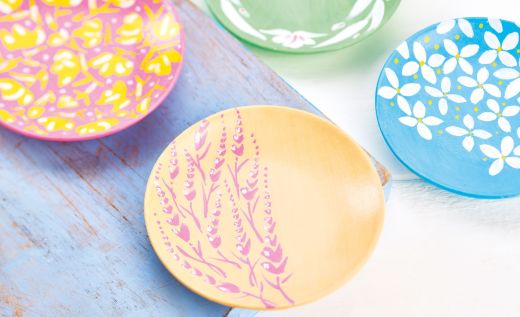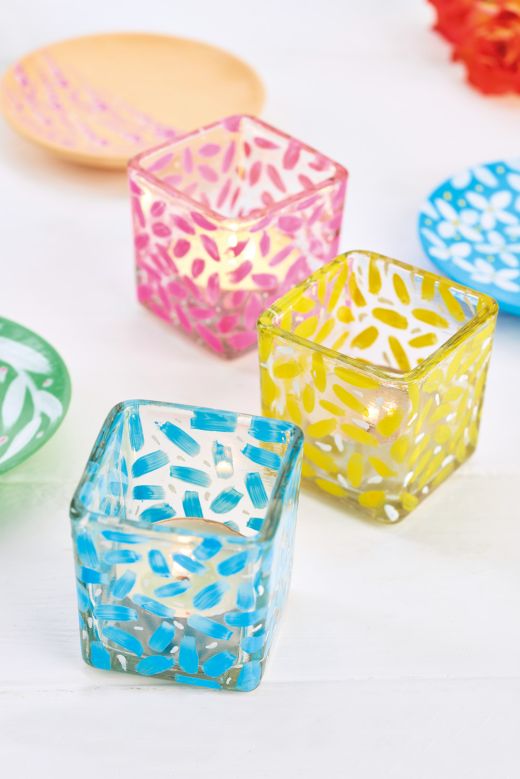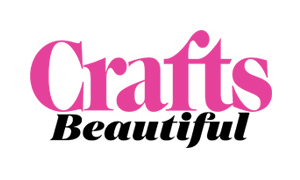Paint glass jars and ceramic plates with easy to use POSCA pens
What you need...
- POSCA PC-5M pens: light orange, light green
POSCA PCF-350 brush tip pens, 8 pack
Small ceramic plates, four
Glass tea light holders, three
Mod Podge clear varnish
Foam brush
instructions
-
Everyone loves a handmade gift, especially one that has an individual, artistic touch and POSCA pens are ideal for this task. Because they work on a range of surfaces such as wood, paper, glass and ceramic, they are the perfect pen for decorating, allowing you to truly personalise your presents. If this is your first time using POSCA pens, Ella Johnston, POSCA Ambassador has some tips and tricks to share...
● Shake the pen well with the cap on before use, to mix the paint.
● Practice your brush strokes on scrap paper before committing your design to ceramics.
● Keep a cloth at hand to clean the tip easily, or absorb any excess paint.
● If the paint flows less freely during use, shake it again, remembering to replace the cap first. -
Pink Buttercup Painted Plate - 1 Paint a plate with a pink PCF- 350 pen. Once it is bone dry, use a yellow PCF-350 pen to draw on a ‘buttercup’ motif. To do this, use the tip to draw a three-tipped zig-zag, rounding off with a curve at the bottom. Fill in with the fullness of the yellow brush.
2 Make sure the flowers are drawn at different angles, so it is not a directional design. Then use the tip to draw the stem and leaves as shown. When the yellow areas are dry, use a white PCF-350 pen to add highlights. Bake and varnish as before. -
DIY Green Painted Plate - 1 Cover a plate with a light green PC-5M pen and allow to dry. Use a white PCF-350 pen to draw three curved lines around the brush as shown. Create leaves by placing the tip at the top, then applying the full brush down toward the curved line.
2 At the top of the plate, create a flower shape by making angled marks on the left and right, followed by a vertical brush mark in the middle. Add highlights with the pink PCF-350 pen. Bake and varnish as before. -
Blue Daisy Plate - 1 Give the plate a base colour with a light blue PCF-350 pen. When dry, design a simple daisy motif, first by using the tip of a yellow PCF-350 pen to make a dot.
2 Make curved petal shapes with a white PCF-350 pen; add one at the top and the bottom of the yellow dot, then another at either side. Use the full brush to fill in, then add little yellow dots with the very tip to complete. Bake and varnish as before. -
Dainty Heather Plate - 1 Create a base colour by painting a plate with a light orange PC-5M pen. When dry, use a pink PCF-350 tip pen for the heather design. Start by using the full volume of the brush to make a ‘v’ shape, then gradually raise it up to create smaller ‘v’s as shown, ending by using the very tip for the smaller top shapes.
2 Hold the brush pen at an angle to create stems and leaves. For a thinner line, use the tip followed by the very top of the brush then, staying at an angle, press it down to create a fuller leaf. Add highlights with the very tip of the white PCF-350 pen. Bake and varnish as before. -
Painted Glass Jars - 1 Clean the tea light holders and dry thoroughly to ensure there is no residual grease or dust on the glass.
2 Use PCF-350 pens to make short, simple, full brush strokes over the surface as shown. Select a contrasting brush colour and use the very tip to add dots around the marks.
3 Once dry, place the votives in an oven at 165° (gas mark 2) for 45 minutes. Once cooled, apply Mod Podge clear varnish with a foam brush.


































